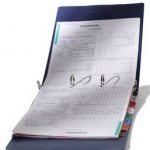 You’re not quite sure. I mean, you’re alone in the exam room. Your giant file is sitting on the counter. You could just sneak a peak—after all, it is YOUR medical information.
You’re not quite sure. I mean, you’re alone in the exam room. Your giant file is sitting on the counter. You could just sneak a peak—after all, it is YOUR medical information.
If you haven’t been keeping your own organized version of your medical history, you’ll experience this kind of curiosity every time you’re in a doctor’s office. What do those files say? Do they have my entire medical history? Does this doctor know about my appointment last week with the specialist? Does he have the full history of my illness?
It will seem unfair, like you’re at the whim of whatever scraps and pieces one doctor or another did or didn’t think was important enough to share.
Collecting, keeping and organizing your medical history is one of the most invaluable tools for patients. Being able to show a doctor your entire medical backstory is the mark of a prepared patient. Records could include relevant test results, diagnosis notes from other physicians, hospitalizations records and even your own recollection of family history, allergies, and food journals.
Here are some tips on collecting and organizing your medical records:
- Be aware that while you do have a right to your medical records, you may have to pay for them. Many doctors offices will charge a few cents per page after a certain page limit. This is only the case when the records are being transferred, in paper, to a patient. All doctor’s offices are obligated to fax or email patient histories to another doctor at a patient’s request.
- You may want to keep a binder of your medical records, instead of storing them in a folder or manila packet. This will give you the ability to organize the records by date, add tabs to show years or symptom onsets. It will also be easier for your doctor to peruse your documents if their in a flip-able format.
- You can also collect your records from hospitalizations by going to the hospital’s billing
 or record departments. They should be able to print you out a stack of your records including what medications they gave you while you were under their care.
or record departments. They should be able to print you out a stack of your records including what medications they gave you while you were under their care. - You may be able to access your records through a patient portal run by either your doctor or hospital. You’ll need to register for an account, but this is a convenient way to access your records.
- There are many great programs coming on the market now to help with managing your medical history. Programs like CareSync upload your records, request new records from your doctors, and have tabs that list all of your diagnoses, symptoms, and medications. You can also allow your doctor to sign-in to access your records at their leisure.